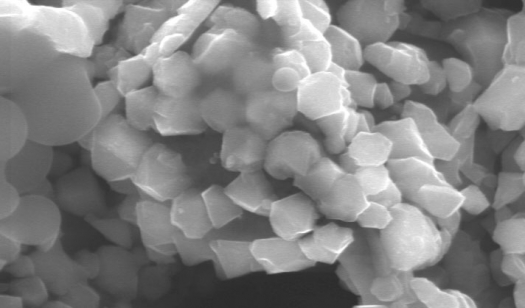Creating silicon crystals at record low temperatures

A new way of making crystalline silicon developed by University of Michigan researchers could make this crucial ingredient of computers and solar cells much cheaper and greener
Silicon dioxide, or sand, makes up about 40 percent of the earth's crust, but the industrial method for converting sand into crystalline silicon is expensive and has a major environmental impact due to the extreme processing conditions.
"The crystalline silicon in modern electronics is currently made through a series of energy-intensive chemical reactions with temperatures in excess of 2,000 degrees Fahrenheit that produces a lot of carbon dioxide," says Stephen Maldonado, professor of chemistry and applied physics.
Recently, Maldonado and chemistry graduate students Junsi Gu and Eli Fahrenkrug discovered a way to make silicon crystals directly at just 1800 F, the internal temperature of a cooked turkey. And they did it by taking advantage of a phenomenon you can see right in your kitchen.
When water is super-saturated with sugar, that sugar can spontaneously form crystals, popularly known as rock candy.
"Instead of water, we're using liquid metal, and instead of sugar, we're using silicon," Maldonado adds.
Liquid metal makes silicon crystals at record low temperatures
Maldonado and his colleagues made a solution containing silicon tetrachloride and layered it over a liquid gallium electrode. Electrons from the metal converted the silicon tetrachloride into raw silicon, which then dissolved into the liquid metal.
"The liquid metal is the key aspect of our process," Maldonado says. "Many solid metals can also deliver electrons that transform silicon tetrachloride into disordered silicon, but only metals like gallium can additionally serve as liquids for silicon crystallization without additional heat."
A scanning electron microscope image at the top of this story shows the pure silicon crystals, generated with the new greener technique.
The researchers reported dark films of silicon crystals accumulating on the surfaces of their liquid gallium electrodes. So far, the crystals are very small, about 1/2000th of a millimetre in diameter, but Maldonado hopes to improve the technique and make larger silicon crystals, tailored for applications such as converting light energy to electricity or storing energy. The team is exploring several variations on the process, including the use of other low-melting-point metal alloys.
If the approach proves viable, the implications could be huge, especially for the solar energy industry. Crystalline silicon is presently the most-used solar energy material, but the cost of silicon has driven many researchers to actively seek alternative semiconductors.
"It's too premature to estimate precisely how much the process could lower the price of silicon, but the potential for a scalable, dramatically less expensive and more environmentally benign process is there," Maldonado adds. "The dream ultimately is to go from sand to crystalline silicon in one step. There's no fundamental law that says this can't be done."
The study, which appears in the, was funded by the American Chemical Society Petroleum Research Fund.
The university is pursuing patent protection for the intellectual property and is seeking commercialisation partners to help bring the technology to market.
A paper entitled "Direct Electrodeposition of Crystalline Silicon at Low Temperatures," by Junsi Gu et al in the Journal of the American Chemical Society describes this work in depth. (DOI: 10.1021/ja310897r)
































